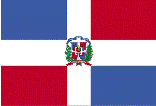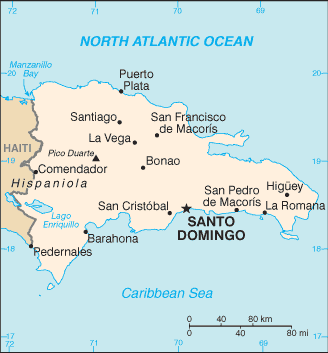|
Dominican Republic
|

|
Capital: Santo Domingo
Population: 10,738,958
Brief History of Dominican Republic:
The Dominican Republic lies on the eastern half of the island of Hispaniola. The island was originally settled by the Native American Tainos, an Arawak people. When Columbus arrived in 1492 on his first voyage to the New World, he claimed the island for Spain. At the time the island was inhabited by hundreds of thousands of Native Americans. The number of Taino people declined rapidly, however, due to diseases brought by the Europeans such as smallpox.
Hispaniola became a springboard for more Spanish exploration and conquest throughout the New World. The city of Santo Domingo was established in 1496 and was the first permanent settlement in the New World.
In 1697 Spain ceded control of the western third of the island to France. In 1804 this part would become the country of Haiti. The Haitians would conquer the rest of the island in 1821, but the eastern two thirds would be granted independence as the country the Dominican Republic in 1844.
The Geography of Dominican Republic
Total Size: 48,730 square km
Size Comparison: slightly more than twice the size of New Hampshire
Geographical Coordinates: 19 00 N, 70 40 W
World Region or Continent: Central America
General Terrain: rugged highlands and mountains with fertile valleys interspersed
Geographical Low Point: Lago Enriquillo -46 m
Geographical High Point: Pico Duarte 3,175 m
Climate: tropical maritime; little seasonal temperature variation; seasonal variation in rainfall
Major cities: SANTO DOMINGO (capital) 2.138 million (2009), Santiago, Puerto Plata
The People of Dominican Republic
Type of Government: representative democracy
Languages Spoken: Spanish
Independence: 27 February 1844 (from Haiti)
National Holiday: Independence Day, 27 February (1844)
Nationality: Dominican(s)
Religions: Roman Catholic 95%
National Symbol: palmchat (bird)
National Anthem or Song: Himno Nacional (National Anthem)
Economy of Dominican Republic
Major Industries: tourism, sugar processing, ferronickel and gold mining, textiles, cement, tobacco
Agricultural Products: sugarcane, coffee, cotton, cocoa, tobacco, rice, beans, potatoes, corn, bananas; cattle, pigs, dairy products, beef, eggs
Natural Resources: nickel, bauxite, gold, silver
Major Exports: ferronickel, sugar, gold, silver, coffee, cocoa, tobacco, meats, consumer goods
Major Imports: foodstuffs, petroleum, cotton and fabrics, chemicals and pharmaceuticals
Currency: Dominican peso (DOP)
National GDP: $93,380,000,000
** Source for population (2012 est.) and GDP (2011 est.) is CIA World Factbook.
Back to Geography Home Page
